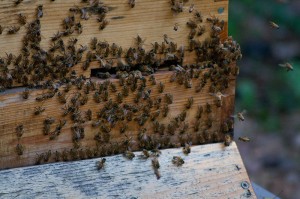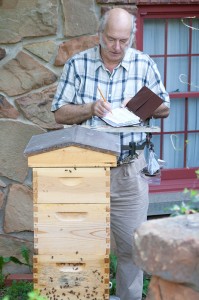OTA professor Clint Stucky’s fascination with bees lands him in NASA project
 When Clint Stucky was 10 years old, he took up the art of beekeeping on the family farm near Alta Mills, Kan., using some old hives he found in his grandmother’s garage and a 3-pound box of bees he purchased mail-order from a Sears, Roebuck and Co. catalogue.
When Clint Stucky was 10 years old, he took up the art of beekeeping on the family farm near Alta Mills, Kan., using some old hives he found in his grandmother’s garage and a 3-pound box of bees he purchased mail-order from a Sears, Roebuck and Co. catalogue.
Today, Stucky cares for four beehives in the back yard of his home in northwest Wichita, and uses a 100-year-old Fairbanks platform scale to weigh 60,000 of his bees each day as part of a nationwide project initiated by the National Aeronautics and Space Administration.
For Stucky, assistant professor of occupational therapy and director of the occupational therapy assistant (OTA) program at Newman University, the NASA project is an interesting development in his life as a beekeeper. Even without it, though, Stucky would continue to keep his bees for other reasons.
He finds them fascinating.
They produce honey.
And they give him something to do in his spare time.
“Everyone needs a hobby,” Stucky said, “and bees are quieter than chickens.”
Dark or light – it’s all good
As a youth, Stucky kept bees at his parents’ farm until he left for college. He took the practice up again as an adult, partly because the increased pollination to his garden would result in better vegetables, but mostly because he remained interested in the creatures. He is one of more than 100,000 beekeepers in the United States today.
 Stucky said his bees produce honey both in the spring and again in early autumn because Kansas has a fall “nectar flow,” or period of time when fall-blooming plants produce nectar for bees to collect. Fall honey is typically darker with a stronger taste than that produced in the summer, he said.
Stucky said his bees produce honey both in the spring and again in early autumn because Kansas has a fall “nectar flow,” or period of time when fall-blooming plants produce nectar for bees to collect. Fall honey is typically darker with a stronger taste than that produced in the summer, he said.
Dark or light, Stucky’s operation produces enough each year for him to give back the bees what they need to keep the hive going over winter, and enough for him to eat and give as gifts, although not enough for him to sell.
Stucky added that keeping bees in an urban setting today is different than his experience keeping bees in the country as a youth. For one thing, urban bees have access to a larger variety of nectar sources – trees and flowers that people plant in the neighborhood, as opposed to a monocultural field of alfalfa in the country.
Still, he noted, his honey production has not been as great as he would like the past two years. There are several possible reasons why.
HoneyBeeNet
As reported in the media, bees are dying off. Colony Collapse Disorder (CCD), where major portions of a beehive population disappear or die suddenly, has wiped out 10 million hives in North America alone since 2007. Stucky said the loss of bees among domestic colonies, or those managed by beekeepers, is approximately 30 percent each year.
Some experts point to pesticides, fungicides, disease-bearing parasites or even poor diet as the cause. Others believe a complicated combination of all of the above is the problem. Another possible cause – or at least a complicating factor – is climate change.
 Some scientists believe the overall health of bees and their pollination activity may be affected by global warming. NASA began a program called HoneyBeeNet in 2008, which combined satellite images of vegetation growth in the Mid-Atlantic region of the U.S. with information provided by volunteer beekeepers of bee activity in the same area at the same time.
Some scientists believe the overall health of bees and their pollination activity may be affected by global warming. NASA began a program called HoneyBeeNet in 2008, which combined satellite images of vegetation growth in the Mid-Atlantic region of the U.S. with information provided by volunteer beekeepers of bee activity in the same area at the same time.
Beekeepers were asked to station their hives on industrial-sized scales, and to weigh the hives each day and report the results to NASA. This data allowed NASA to monitor changes in the hives, which can illustrate the abundance and duration of nectar flow. A rapid increase in weight, for example, indicates heavy nectar intake. A steady loss of weight would indicate that nectar sources have gone dry, causing bees to consume honey stored in the hive.
By comparing this data to satellite images, scientists can better understand how changes in climate are affecting the time plants bloom and their ability to produce nectar. Early results of HoneyBeeNet showed that in Maryland, the peak nectar flow occurred almost four weeks earlier than in the 1970s – an indication of climate changes and the warming effect of urbanization.
When the program was extended to cover more areas of the country, Stucky applied and was accepted as “KS001,” the first NASA bee observer in Kansas. As of the time this magazine went to press, Stucky was in fact the only NASA bee observer in Kansas. According to NASA, there are none in the states of Nebraska, Oklahoma, Iowa, Wyoming, South Dakota and Texas.
Wrangling bees
Since being told he was a participant in the project, Stucky has weighed his bees each day and meticulously recorded the information. He also takes note of weather conditions. He sends all the data to NASA on a regular basis.
While Stucky said he is glad to be part of the NASA project, he added that raising bees is more challenging today than when he was 10. Beekeepers must take more precautions today because there are more predators – for example, tiny mites that attach themselves to bees – as well as viruses and fungi that descend on bees and weaken them.
Beekeepers must also maintain the right balance of bees in a hive, and understand bee behavior and hive organization, which is complex.
For all these problems, however, Stucky shows no sign of quitting the practice of beekeeping. After all, he said with a philosophical tone, managing any kind of live creatures can be a challenge.
“Working with bees is like working with any livestock, such as horses,” Stucky said. “There are just more of them.”
– Ken Arnold
Tags: Bees, Clint Stucky, NASA, Newman
